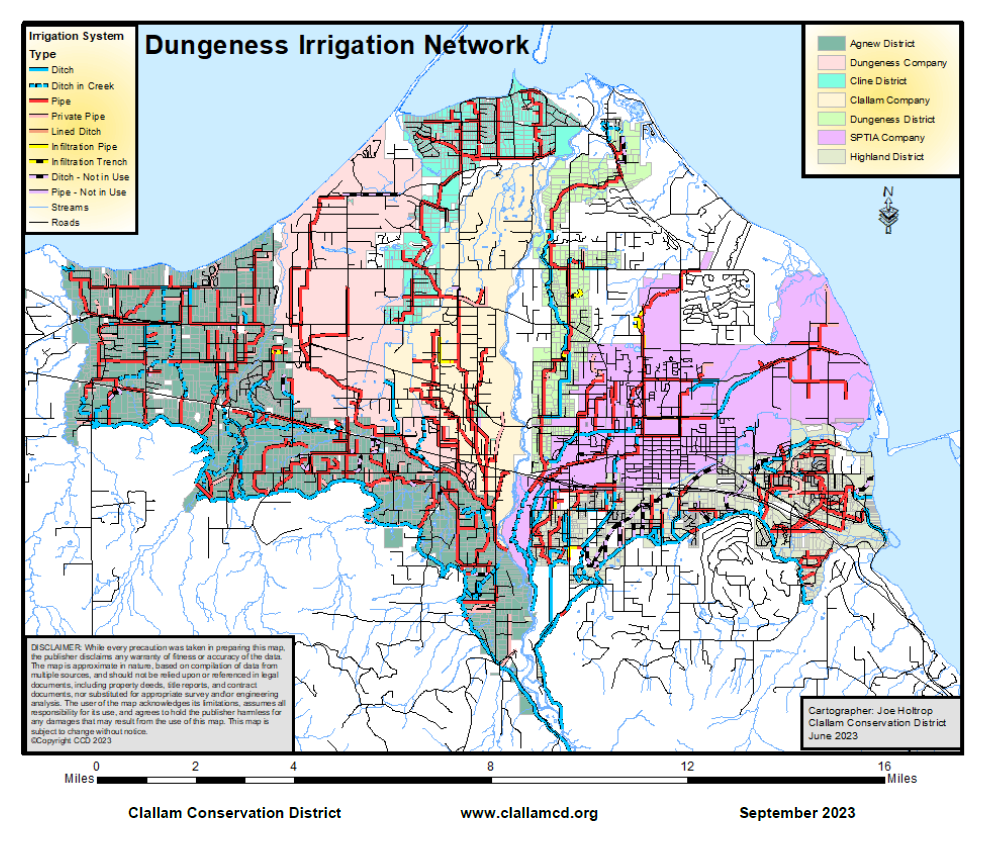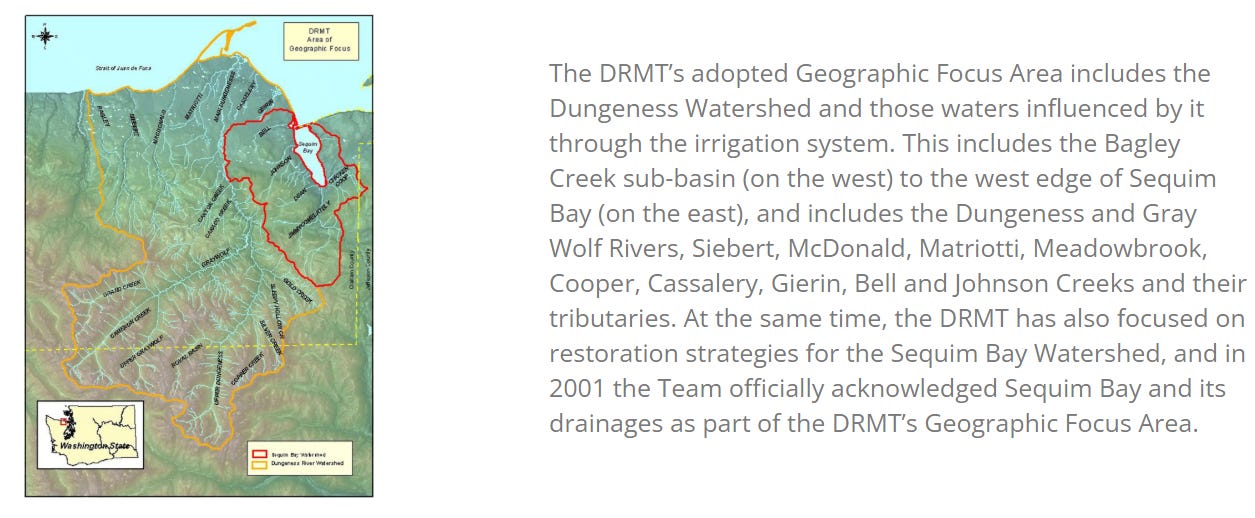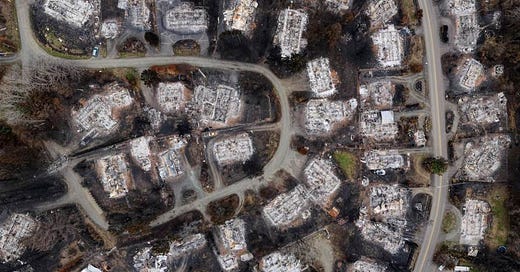What if there were a system of canals in wildfire territory? Ozias, the Tribe, and a River walk into a bar… what could go wrong? The art of keeping the public uninformed. Step one: demand a reservoir, Step two: figure out why we need one.
Houses engulfed in flames, embers leaping from home to home, row after row of city blocks incinerated, and water pipelines left without a drop.
Would dry regions benefit from having a network of open canals that delivered water to properties? Imagine if those canals charged aquifers so residents with wells could depend on a water source if fire engines couldn’t respond or if fire hydrants went dry. What if the canals formed a network of fire-suppressing green belts that hindered flames from spreading across a prairie that rarely saw rain?
The dry side of Clallam County has had such a network of canals since the 1800s, but they are disappearing as a controversial irrigation ditch piping project continues.

Change in leadership
The Dungeness River Management Team (DRMT) is a partnership between Clallam County, the Jamestown Tribe, and other “individuals and stakeholders.” While the DRMT has been credited with leading efforts in water conservation and reducing pollution, it also supports controversial projects.

The DRMT is a proponent of piping Sequim’s historic irrigation ditches without property owner consent or proper easements, even though the County and City of Sequim have acknowledged that the project may cause wells to go dry. The DRMT is also a proponent of the controversial Dungeness River Off-Channel Reservoir — a massive above-ground reservoir to be constructed atop earthquake fault lines south of Sequim.
Serving on the DRMT can be politically prestigious. Clallam County Commissioner Steve Tharinger was chairman before his ascension to Olympia for State Representative. The DRMT played a role in determining that the County should buy Commissioner Tharinger’s house and land at an above-market price to prepare for the Lower Dungeness Floodplain Restoration Program.
This year, the DRMT has a new chairman.
“I was asked to sit on the, to chair actually for this upcoming year [2025], the Dungeness River Management Team” Commissioner Mark Ozias disclosed to his fellow commissioners in December.
In the wake of the Towne Road debacle, which left millions in taxpayer funds unaccounted for and nearly subjected the community of Dungeness to a mass-casualty flooding event, Commissioner Ozias and the Jamestown Tribe are partnering again.
A pattern continues
As has become customary when Clallam County and the Jamestown Tribe collaborate, there is no shortage of non-governmental organizations (NGOs) using public funds to further special interest agendas while hiding information from the public record.
The Stockholm Environment Institute (SEI) has been working with the DRMT and presented the results of their water model last month. SEI is registered under Swedish Law and funded by the Swedish government. It aims to “shift global policy and practice” and partners with ICLEI, a German NGO to which the Jamestown Tribe belongs.

SEI is working with Washington Water Trust (WWT) to decide where the reservoir's water comes from and goes and when and how much water will flow. The WWT does not participate in public records requests because it is not a public entity. Several Washington State Tribes, including Jamestown, support the WWT.
According to Washington’s Secretary of State office, WWT is a charitable non-profit with a sole “governor,” William Stelle, who served with the Senate Indian Affairs Committee in Washington, D.C., and was a political appointee of Presidents Clinton and Obama.
Time to reboot
The future reservoir lacks funds for maintenance and repair.
“We still do not have a… funding source to fund the ongoing operations and maintenance of our reservoir project,” said Ben Smith, Board Director of the Highland Irrigation District, during a November 22nd Off-Channel Reservoir Work Group Meeting.
Smith explained that if the reservoir is shifting more toward an agricultural benefit (by providing irrigation to farmers) than a fish benefit (by keeping more water in the river during late summer), “then it would be natural that the ag community would be required to shoulder the ongoing maintenance of that.”
“My original concept,” said Smith, “was that this was very highly beneficial to the river and therefore it would be justified to ask for county, state, public funds because everybody benefits by fish resource improvement — that it would be appropriate to ask the larger community to fund the maintenance of this.”
Smith said the topic continues to be shoved aside, but he likened it to the third leg missing from a three-legged stool. He said, “I cannot see a vision where the ag community will be able to shoulder that financial burden.”
Additionally, if farmers are forced to cease irrigating the final 30 or 45 days of every summer as they have been in recent years, paying for reservoir maintenance will be even more challenging.
“We are looking hard at any other types of management operations that can make this reservoir be the benefit it was originally thought of,” said Clallam County Public Works Director Steve Gray. “This is the time to really dig down.”
Gray detailed what has fallen in place thus far to support the project:
The County has secured grant funding for the reservoir design.
The location has been determined (and purchased by the County).
Hazardous material will be removed from the site.
The County is working with the City of Sequim on a project that addresses stormwater management and aquifer infiltration.
FEMA is reviewing the $30 million grant request.
“If we can figure this out, that there’s still a benefit of this reservoir, this is our opportunity to do that,” Gray explained to representatives from the Jamestown Tribe, Department of Ecology, and WWT at the meeting. “I don’t see this opportunity coming again.”
“We just need to reboot and relook at this and see if there’s a different way to use this water to benefit not just ag but fish and recharging our aquifers,” Gray said in closing.
Open to the public
DRMT meetings are held from 2:00 to 5:00 p.m. on the second Wednesday of every month. They are open to the public and hosted by the Jamestown Tribe at the Dungeness River Nature Center. Click here for more details
.




I'll reiterate that the county charter should prohibit county commissioners from serving on or being members of any other organization. That includes Rotary, CofC, Boy Scouts, etc.
Am I understanding this correctly? Fish are more important than all the other foods grown locally? By the looks of CC residents, tribal and non-tribal, everyone likes to eat, and not just fish. Why do foreign entities base funding on fish? For over 20 years, CA has been basing its water and agricultural laws and regulations on fish. With all the fires and devastion happening again and again and again, CA still won't learn or change. WA is heading in that direction. God, please help us! Thank you, Jeff!